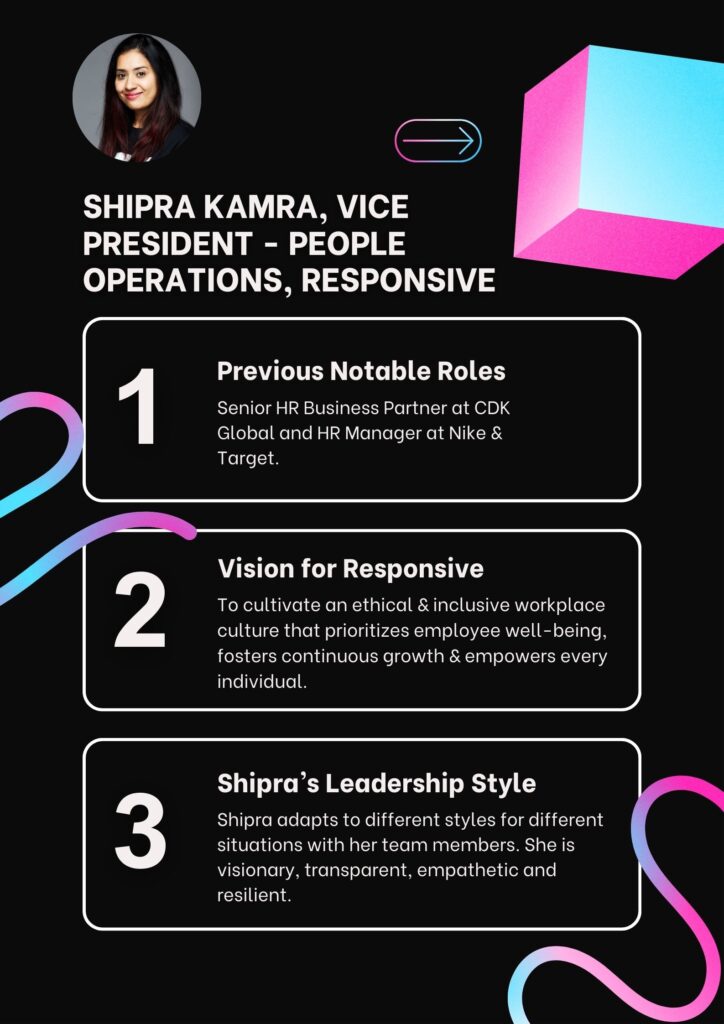
Responsive is a strategic response management solutions provider. As part of The Smart CEO CXO HR Series, Shipra Kamra, Head of People Operations at this organization, talked to us about her role as the HR head, the evolving HR scenario, and the challenges she faces on a day-to-day basis, like managing remote working, training a new generation of employees with no exposure to working in a corporate environment, isolation, and engagement. The HR plate is effectively full, but Kamra believes AI-based solutions can help deal with most of these new-age challenges.
AI’s Impact on Workforce Planning
How is AI influencing your strategies for workforce planning and the future of work in your organization?
We use AI-based solutions for headhunting and also plan to use the data to change our workforce planning and strategy. We are looking at some new software that can integrate and automate processes for speed and are in the process of building bots that will change the way our team will function. Bots will improve responses to standard queries and minimize the load on the HR team, allowing them to focus on strategic work. This is still in its early stages and we hope to have it up and running in the next few months.
Workforce Strategy
How do you align your workforce strategy with the overall business objectives of the company?
Our workforce planning strategy focuses on trying to align everybody in one direction. This is very mission-critical because, if everybody is rowing the boat in different directions, we will never reach our destination. At the organizational level, there must be one goal and everyone must steer towards it.
Last year we rallied around the cry, ‘One Team, One Mission’. We started with setting the organization’s objectives for 2023 on the top and cascading them down to the rest of our teams, delivering that mission to the last person in the organization.
For the HR team, this involved examining the hiring strategy and defining the profile of the people we wanted to target. The next step was to identify the potential sources to recruit from and establish processes to align them with the goals of the organization and their respective teams. This includes providing them with sufficient training and content to induct them into the company.
For the new and existing employees, we felt making them feel a part of the organization is essential. Therefore, we identified ways to engage them, facilitating their professional development in the organization, re-enabling them to take on higher or different roles.
When companies grow, their original culture starts evolving and changing. This can be good, but sometimes, we also need to preserve our old value systems. Leaders lead the way in ensuring this and HR plays a very strong role in ensuring conformance at every level.
Talent Acquisition and Retention
What innovative approaches have you implemented to attract and retain top talent in a competitive market?
The company has hired a lot in the last two years, almost doubling our headcount. Especially in this last year, when most companies were not hiring or laying off people, our growth momentum continued.
Our technical teams are very picky on who they hire. They want high technical skills and aptitude. So, in addition to examining the applications for jobs, we identify the skill gaps and how to fulfill them. To attract talent, we actively communicate our unique selling point. And though we are not a large company, we are not very small either, and we have a well-established brand reputation.
Some of our USPs include enabling a healthy work-life balance, following an ingrained value system, and promoting work culture. This has also enabled us to retain employees who don’t even mind commuting long distances, because they believe in us.

Employee Development and Engagement
How do you ensure continuous employee development and maintain high levels of engagement?
We have created policies to support employees in upskilling themselves with the right certification programs. We have sent many of our people to management to create a growth path based on potential. Some of the certification programs, with focused curriculum, take a whole year.
To encourage employee engagement, one of the company’s core values is called S4 or ‘See Something, Say Something’. The Responsive CEO, Ganesh, was inspired to coin this term when he was traveling and saw a similar motto for involving passengers in improving security. He felt it was a great idea as everybody must report anything that does not look right or there’s an opportunity for us.
We have an anonymous feedback suggestion form that employees can drop in a box anonymously, without fear of retaliation. Now that remote working has also become common, we have replicated it online with a digital form.
These feedbacks help us understand and improve.
Adapting to Change
How has the role of HR evolved in your organization in response to changing work environments, such as remote work and digital transformation?
Building workforce strategy involves understanding the needs of the talent, and as the organization evolves, employees’ expectations too change. In remote environment, people are not as connected as they were in the office. Earlier, they were learning by watching others, but that flow has broken down. There is only a limited purpose textual communication can serve. Interactions with mentors, bosses, and peers are important.
The organization has put in a lot of effort to create an environment that allows hands-on learning on a monthly basis. Earlier, it used to be done quarterly. We connect more with our employees so that they can understand what’s happening, increase transparency to organizational goals, the market, and how they will impact individual roles.
With increased communication, people are learning more. We also create a lot of systems internally where they can have information readily available to them in a centralized repository. We also have a lot of communication channels that we enhance so that people can connect more quickly with others.

Performance Management
Tell us one amazing aspect of your organization’s performance management approach.
We have a performance management cycle that we introduced early in the company to identify:
- Who the top talents are
- How we are going to facilitate their growth in the organization
We have created a lot of career paths and the team leaders must take the initiative to facilitate the grow of their team.
Growth is not just vertical, as not everybody wants to be a manager. A technical person may want to go deeper into the technology area of their interest. But, due to a lack of visibility on what options are available, they may take the traditional career path. We create those paths internally, saying you have ways to grow without becoming a manager, you don’t have to take up something due to the absence of a choice.
The top talent is rewarded in every possible way so that they are engaged and continue to stay with us and we don’t lose the talent to market.
Employee Well-being
What is the organization’s role in employee well-being?
COVID was a stressful period. Some lost their loved ones, some had to manage kids with no support system. Sometimes there were different kinds of challenges, health issues that people faced, and the isolation added to it.
At Responsive, we have focused on making sure that some of the benefits are accessible to our employees. The company conducts yoga every week, at no charge for the employees. We provide free meals in the organization. Other than that, we have also taken some subscriptions to health-related tasks.
Mental health has come into focus due to the isolation as you can connect on video chats only for brief periods with your colleagues, there are no impromptu water-cooler chats, and so on. So we have created some hubs where we enable hybrid options such as working from anywhere four days a week. This improves the bonding between team members, improves collaboration and creates a sense of belonging.
HR Technology
Tell us your favourite HRTech tools
We use Headspace in our US office to promote physical and mental well-being, We are looking at something comparable in India to benefit our Indian employees.
We use Culture Amp, a survey tool, to take feedback from our employees anonymously.
Trello Board is more like a project management tool that helps us track the progress of the many different projects we are working on.
Future Challenges and Opportunities in HR
What do you see as the biggest challenges and opportunities facing HR in the next few years?
The industry is shifting and a new workforce is entering. The style of managing them versus how it was 20 years ago is completely different.
The new generation is very, very exciting. I think they’re very innovative. They have a better risk appetite. They are willing to try a new startup with absolutely no background of whether it will be successful or not.
Engaging that talent takes a lot more effort because if you do not engage them, if they’re not getting the kick out of what they want to, they’ll just move on to other organizations. So, making sure that the engagement is really good, giving them a growth path, and giving them challenges at the right time before they start disengaging is very important.
A lot of changes in the work style have happened in the last three years. Some of them never saw an actual office. They were never integrated. They may not even know what corporate expectations are as a person or as a professional. These are some other challenges and we need to invest in these basics again. It does look as if we are sliding back, but if we don’t do it now, a few years later, we will see the gap when we are looking for managers or leaders because we didn’t do it at the right time. So we must make sure that the developmental opportunities are identified to provide training from a growth standpoint, and by giving feedback, if needed. This will need to be balanced with the need to preserve flexibility and independence while facilitating collaboration.